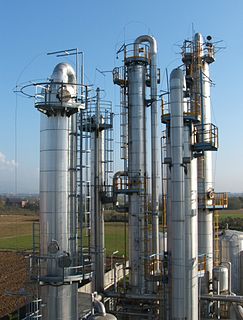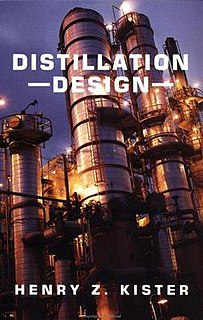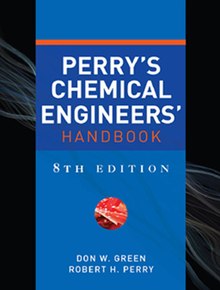
Distillation, or classical distillation, is the process of separating the components or substances from a liquid mixture by using selective boiling and condensation. Dry distillation is the heating of solid materials to produce gaseous products. Dry distillation may involve chemical changes such as destructive distillation or cracking and is not discussed under this article. Distillation may result in essentially complete separation, or it may be a partial separation that increases the concentration of selected components in the mixture. In either case, the process exploits differences in the relative volatility of the mixture's components. In industrial applications, distillation is a unit operation of practically universal importance, but it is a physical separation process, not a chemical reaction.

A fractionating column or fractional column is an essential item used in the distillation of liquid mixtures to separate the mixture into its component parts, or fractions, based on the differences in volatilities. Fractionating columns are used in small scale laboratory distillations as well as large scale industrial distillations.

Fractional freezing is a process used in process engineering and chemistry to separate substances with different melting points. It can be done by partial melting of a solid, for example in zone refining of silicon or metals, or by partial crystallization of a liquid, as in freeze distillation, also called normal freezing or progressive freezing. The initial sample is thus fractionated.

Continuous distillation, a form of distillation, is an ongoing separation in which a mixture is continuously fed into the process and separated fractions are removed continuously as output streams. Distillation is the separation or partial separation of a liquid feed mixture into components or fractions by selective boiling and condensation. The process produces at least two output fractions. These fractions include at least one volatile distillate fraction, which has boiled and been separately captured as a vapor condensed to a liquid, and practically always a bottoms fraction, which is the least volatile residue that has not been separately captured as a condensed vapor.
In chemical engineering, process design is the choice and sequencing of units for desired physical and/or chemical transformation of materials. Process design is central to chemical engineering, and it can be considered to be the summit of that field, bringing together all of the field's components.

In chemical processing, a packed bed is a hollow tube, pipe, or other vessel that is filled with a packing material. The packing can be randomly filled with small objects like Raschig rings or else it can be a specifically designed structured packing. Packed beds may also contain catalyst particles or adsorbents such as zeolite pellets, granular activated carbon, etc.
Transport Phenomena is the first textbook about transport phenomena. It is specifically designed for chemical engineering students. The first edition was published in 1960, two years after having been preliminarily published under the title Notes on Transport Phenomena based on mimeographed notes prepared for a chemical engineering course taught at the University of Wisconsin–Madison during the academic year 1957-1958. The second edition was published in August 2001. A revised second edition was published in 2007. This text is often known simply as BSL after its authors' initials.
Batch distillation refers to the use of distillation in batches, meaning that a mixture is distilled to separate it into its component fractions before the distillation still is again charged with more mixture and the process is repeated. This is in contrast with continuous distillation where the feedstock is added and the distillate drawn off without interruption. Batch distillation has always been an important part of the production of seasonal, or low capacity and high-purity chemicals. It is a very frequent separation process in the pharmaceutical industry.
Reboilers are heat exchangers typically used to provide heat to the bottom of industrial distillation columns. They boil the liquid from the bottom of a distillation column to generate vapors which are returned to the column to drive the distillation separation. The heat supplied to the column by the reboiler at the bottom of the column is removed by the condenser at the top of the column.

Distillation Design is a book which provides complete coverage of the design of industrial distillation columns for the petroleum refining, chemical and petrochemical plants, natural gas processing, pharmaceutical, food and alcohol distilling industries. It has been a classical chemical engineering textbook since it was first published in February 1992.

Unit Operations of Chemical Engineering, first published in 1956, is one of the oldest chemical engineering textbooks still in widespread use. The current Seventh Edition, published in 2004, continues its successful tradition of being used as a textbook in university undergraduate chemical engineering courses. It is widely used in colleges and universities throughout the world, and often referred just "McCabe-Smith-Harriott" or "MSH".
The McCabe–Thiele method is considered to be the simplest and perhaps most instructive method for the analysis of binary distillation. It uses the fact that the composition at each theoretical tray is completely determined by the mole fraction of one of the two components and is based on the assumption of constant molar overflow which requires that:
A theoretical plate in many separation processes is a hypothetical zone or stage in which two phases, such as the liquid and vapor phases of a substance, establish an equilibrium with each other. Such equilibrium stages may also be referred to as an equilibrium stage, ideal stage, or a theoretical tray. The performance of many separation processes depends on having series of equilibrium stages and is enhanced by providing more such stages. In other words, having more theoretical plates increases the efficiency of the separation process be it either a distillation, absorption, chromatographic, adsorption or similar process.
Robert H. Perry (1924–1978) was the second editor of the popular reference work Perry's Chemical Engineers' Handbook, originally edited by his father, John H. Perry, with the first edition published in 1934.
The COCO Simulator is a free-of-charge, non-commercial, graphical, modular and CAPE-OPEN compliant, steady-state, sequential simulation process modeling environment. It was originally intended as a test environment for CAPE-OPEN modeling tools but now provides free chemical process simulation for students. It is an open flowsheet modeling environment allowing anyone to add new unit operations or thermodynamics packages.
Relative volatility is a measure comparing the vapor pressures of the components in a liquid mixture of chemicals. This quantity is widely used in designing large industrial distillation processes. In effect, it indicates the ease or difficulty of using distillation to separate the more volatile components from the less volatile components in a mixture. By convention, relative volatility is usually denoted as .

Reflux is a technique involving the condensation of vapors and the return of this condensate to the system from which it originated. It is used in industrial and laboratory distillations. It is also used in chemistry to supply energy to reactions over a long period of time.

Flottweg SE is a manufacturer of machines and systems for mechanical liquid-solid separation. The headquarters is located in Vilsbiburg (Bavaria), Germany. The company develops and produces decanter centrifuges, separators and belt presses. Flottweg has subsidiaries and branch offices with service centers in the United States, People´s Republic of China, Russia, Italy, Poland, France, Australia and Mexico.
A plate column is a chemical equipment used to carry out unit operations where it is necessary to transfer mass between a liquid phase and a gas phase. In other words, it is a particular gas-liquid contactor. The peculiarity of this gas-liquid contactor is that the gas comes in contact with liquid through different stages; each stage is delimited by two plates.
A gas–liquid contactor is a particular chemical equipment used to realize the mass and heat transfer between a gas phase and a liquid phase. Gas–liquid contactors can be used in separation processes or as gas–liquid reactors or to achieve both purposes within the same device.









